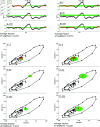Signals of complexity and fragmentation in accelerometer data
- PMID: 40632775
- PMCID: PMC12240345
- DOI: 10.1371/journal.pone.0326522
Signals of complexity and fragmentation in accelerometer data
Abstract
There is a growing interest to analyze physiological data from a complex systems perspective. Accelerometer data is one type of data that is easy to obtain but often difficult to analyze for insights beyond basic levels of description. Previous work hypothesizes that an individual's activity pattern can be seen as a complex dynamical system. Here, we explore this hypothesis further by investigating whether complexity-based measures quantifying repetitiveness and fragmentation of activity captured via accelerometer can detect health differences beyond traditional measures. Our results demonstrate that healthy individuals have a higher regularity (indicated by a lower correlation dimension), a higher probability of activity after a period of rest, and a lower probability of a period of rest after a period of activity compared with patients living with Myotonic Dystrophy type I (DM1), a chronic, progressive, complex, multisystem disease. For the correlation dimension, this difference was independent of the average, coefficient of variation and autocorrelation of the activity signals. This suggests that the correlation dimension can extract clinically relevant information from accelerometer data. Therefore, our results corroborate the idea that a complexity perspective may help to reveal the emergent characteristics of health and disease.
Copyright: © 2025 Weinans et al. This is an open access article distributed under the terms of the Creative Commons Attribution License, which permits unrestricted use, distribution, and reproduction in any medium, provided the original author and source are credited.
Conflict of interest statement
The authors have declared that no competing interests exist.
Figures







References
-
- Salomon JA, Mathers CD, Chatterji S, Sadana R, Ustun TB, Murray CJ. Quantifying individual levels of health: definitions, concepts and measurement issues. Health systems performance assessment: debate, methods, and empiricism. 2003. p. 301–18.
-
- Burger J, van der Veen DC, Robinaugh DJ, Quax R, Riese H, Schoevers RA, et al. Bridging the gap between complexity science and clinical practice by formalizing idiographic theories: a computational model of functional analysis. BMC Med. 2020;18(1):99. doi: 10.1186/s12916-020-01558-1 - DOI - PMC - PubMed
MeSH terms
LinkOut - more resources
Full Text Sources

